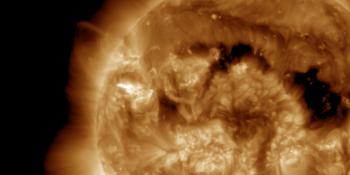Przeglądasz Archiwum z czwartek, 16 sierpnia 2001
Raport aktywności słonecznej
Każdy wspomniany rozbłysk słoneczny w tym raporcie ma współczynnik skalowania dodany przez Space Weather Prediction Center (SWPC). Przez skale współczynników SWPC, raporty o rozbłyskach słonecznych są o 42% mniejsze niż naukowo jakościowa data. Skale współczynników zostały usunięte z naszych archiwów o rozbłyskach słonecznych by odzwierciedlić prawdziwe jednostki fizyczne.
Raport aktywności słoneczno- geomagnetycznej 2001 Aug 16 2200 UTCPrzygotowane przez NOAA © SWPC i przetworzone przez SpaceWeatherLive.com
Połączenie raportów USAF/NOAA o słonecznej i geofizycznej aktywności
Numer SDF 228 wydany w 2200Z na 16 Aug 2001IA. Analiza aktywności regionów słonecznych i aktywność od 15-2100Z do 16-2100Z Solar activity from numbered regions on the visible
disk was low. Impulsive B- and C-class flares were observed
throughout the period, the largest being an optically uncorrelated
C3 flare at 16/0957 UTC. However, the most impressive activity of
the day was a remarkable backside CME, observed on SOHO/LASCO
starting at about 15/2355 UTC. This event resulted in the proton
enhancements discussed in section IIA below. The observed CME
together with backside imagery inferred from the SOHO/MDI instrument
suggest old Region 9557 (S20, L=283) as the likely source, presently
located near the far backside central meridian. On the visible
disk, three new regions were numbered today: 9583 (S23E13), 9584
(S11E60), and 9585 (N15E74). All appear to be small, simply
structured beta-class groups with low flare activity potential.
IB. Prognoza aktywności słonecznej
Solar activity on the visible disk is
expected to persist at mainly low levels for the next three days.
IIA. Podsumowanie aktywności geofizycznej 15-2100Z do 16-2100Z
Geomagnetic field activity has been quiet to unsettled throughout the
period. A major proton event for >= 100MeV protons above 1pfu began
at 16/0105 UTC, followed by >= 10Mev protons above 10pfu at 16/0135
UTC. Maximum flux for 100Mev protons was 29pfu at 16/0305 UTC, and
for 10MeV protons was 493pfu at 16/0355 UTC. Both events remain in
progress, and represent a record response for a presumed CME source
so far behind the western limb as described in section 1A above.
Greater than 2MeV electrons were observed at moderate enhancement
levels again today, although the electron sensor on GOES-8 was
saturated by the proton event for much of the period.
IIB. Prognoza aktywności geofizycznej
The geomagnetic field is
expected to be at active to minor storm levels within 24 hours, in
response to anticipated shock passage from CME activity reported on
August 14th. Isolated major storm periods may also be possible at
higher latitudes, as well as an enhancement of 10MeV proton levels
for the event in progress. Geomagnetic storm activity is expected
to wane during day two, along with the 100MeV proton event. The
10MeV proton event is expected to persist at levels above 10pfu into
day three. Greater than 2MeV electrons are also expected to persist
at moderate enhancement levels.
III. Prawdopodobieństwa zdarzenia 17 Aug do 19 Aug
| Klasa M | 25% | 25% | 25% |
| Klasa X | 01% | 01% | 01% |
| Proton | 99% | 95% | 90% |
| PCAF | red | ||
IV. Przepływ 10,7 cm z Penticton
Zaobserwowano 16 Aug 143 Przewidywane 17 Aug-19 Aug 140/140/145 Średnia z 90 dni 16 Aug 151
V. Indeks geomagnetyczny A
Zaobserwowano Afr/Ap 15 Aug 004/009 Szacowane Afr/Ap 16 Aug 007/008 Przewidywane Afr/Ap 17 Aug-19 Aug 025/020-017/015-012/018
VI. Prawdopodobieństwa aktywności geomagnetycznej 17 Aug do 19 Aug
| A. Średnie szerokości geograficzne | |||
|---|---|---|---|
| Aktywne | 35% | 30% | 25% |
| Słaba burza | 20% | 15% | 10% |
| Bardzo znacząca burza | 10% | 05% | 05% |
| B. Wysokie szerokości geograficzne | |||
|---|---|---|---|
| Aktywne | 40% | 30% | 30% |
| Słaba burza | 20% | 15% | 15% |
| Bardzo znacząca burza | 05% | 05% | 05% |
Wszystkie czasy w UTC
<< Idź do codziennego przeglądu
Najnowsze wiadomości
Najnowsze wiadomości z forum
AR 3959 14IP cameras for sky surveillance 41Comet C/2024 G3 (ATLAS) in LASCO C3 10Unspecified geomagnetic activity 1836Filaments and prominences 612
Więcej tematówWesprzyj SpaceWeatherLive.com!
Wielu ludzi odwiedza SpaceWeatherLive aby śledzić aktywność słoneczną lub sprawdzić czy jest szansa na zaobserwowanie zorzy polarnej. Niestety, większy ruch na stronie oznacza większe koszty utrzymania serwera. Dlatego, jeśli jesteś zadowolony ze strony SpaceWeatherLive, zachęcamy do wspierania nas finansowo. Dzięki temu będziemy mogli utrzymać naszą stronę.

Fakty na temat pogody kosmicznej
| Ostatnie rozbłyski klasy X | 2025/01/04 | X1.85 |
| Ostatnie rozbłyski klasy M | 2025/01/09 | M1.1 |
| Ostatnia burza geomagnetyczna | 2025/01/04 | Kp5 (G1) |
| Dni bez plam słonecznych | |
|---|---|
| Ostatni dzień bez skazy | 2022/06/08 |
| Średnia miesięczna liczba plam słonecznych | |
|---|---|
| grudnia 2024 | 154.5 +2 |
| stycznia 2025 | 140.8 -13.8 |
| Ostatnie 30 dni | 151.7 +34.3 |


